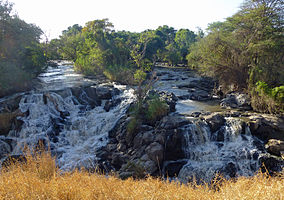Mammals and Reptiles
Awash national park is home to more than 81 species of mammals and 43 species of reptiles. Beisa oryxes are common here for their populations. Other species that live within these park ecoregions include Aardvarks, Aardwolves, caracals, servals, hippopotamuses, Crested porcupines, Spotted hyenas, Striped hyenas, lions, leopards, cheetahs, Soemmerring's gazelles, Defassa waterbucks, Spotted-necked otters, Rock hyraxes, klipspringers, Salt's dik-diks, lesser kudus, greater kudus, and warthogs. Swayne's hartebeests were translocated to Awash national park for repopulation but their presence is left uncertain due to their population decline and environmental change. Primates of Awash National park such as Olive baboons, guerezas, grivets, and hamadryas baboons are abundantly common throughout the park's ecosystems. [6] [7] [8] [9] Animals such as elephants, rhinos, zebras, and Cape buffalo were once presented since the 1960s but were now extirpated because of hunting, population decline, and habitat loss.
Nile crocodiles are found in Awash river valleys and gorges while Rock pythons are found in riverine forests and hot spring oases. Leopard tortoises are rarely seen on savanna grassland and dry thickets for feeding, which is the only tortoise species listed here. Venomous snakes, such as Saw-scaled viper (Echis carinatus pyramidum), Puff adder (Bitis arietans somalica), Rhombic night-adder (Causus rhombeatus), Black mamba (Dendroaspis polylepis antinori), Eastern pallid spitting cobra (Naja mossambica pallida), and Black-necked spitting cobra (Naja nigricollis), are frequently found within the park ecosystems that are considered dangerous for encountering them. Other reptile species such as geckos, skinks, agamas, snakes, and monitors are frequently diverse in arid scrublands and riverine wetlands. [10]
Avifauna
The park also contains 453 species of native birds which includes Somali ostriches, Lappet-faced vultures, White-bellied go-away-birds, Crested francolins, White-headed buffalo weavers, Chestnut-headed sparrow-larks, Northern carmine bee-eaters, Kori bustards, Abyssinian rollers, Abyssinian ground hornbills, Red-billed hornbill, and Brown snake-eagles. Wattled Ibis (Bostrychia carunculata), Black-winged lovebird (Agapornis taranta), Banded barbet (Lybiusun datus), Yellow-throated seedeater (Crithagra flavigula), Abyssinian woodpecker (Dendropicos abyssinicus), White-billed starling (Onychognathus albirostris), and Thick-billed raven (Corvus crassirostris) are 7 endemic species that are compromised within the park's biodiversity. [11] [12] [13]






